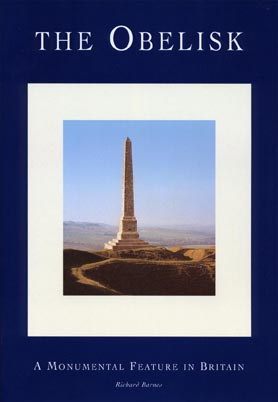Frontier Sculpture & Monuments

The Obelisk: A Monumental Feature in Britain
The Obelisk: A Monumental Feature in Britain
Richard Barnes
238 x 164mm, 240 pp, inc 48 pp col ill
ISBN: 978-1-872914-28-2, £35.00
Obelisks in Britain have a long history, which began when English travellers
saw and admired in Rome the obelisks which the emperors of old had pillaged
from Egypt. The shape of the four sided tapering stone upright, with a pyramidion
at its peak, was unforgettable. The first obelisk to arrive was of marble,
brought by a courtier to Nonsuch Palace in England in about 1570 and, with
it, a line of lesser obelisks to form a balustrade. The feature was copied
at Montacute House and around Jacobean church tombs.
The first large obelisks, of dressed stone blocks, were Hawksmoor and Vanbrugh’s
monuments, in Ripon (1702) and at Castle Howard. A tale is recounted of the two
architects’ dismissal from Blenheim Palace, despite Hawksmoor’s ‘Explanation
of the Obelisk’. The procession of outstanding 18th century architects
continued with Kent, Gibbs, Dance, Adam and Soane, all of whom favoured obelisks
in fine parks and gardens. There were new uses too, as landmarks and coastal
points, hilltop eyecatchers, milestones, and village crossroads - all very
British, as were the quirky inscriptions and pinpoint locations across the
land.
After the obelisk had been in England for two hundred years, the picture was
altered by discoveries in Egypt. Five Ancient Egyptian obelisks were gradually
removed to Britain, the last to arrive being Cleopatra’s Needle in London.
From 1800, however, British obelisks stood comparison with the ‘real’ thing.
In Victorian times the progress of the obelisk was intense: the trail leads around
the country, to masons’ yards, granite quarries and the phenomenal new
cemeteries, with their astonishing wealth of monolithic obelisk memorials of
polished granite.
Readers of Richard Barnes’s previous book about the sculptor, John Bell,1811-1895,
will appreciate the inclusion of texts of Bell’s lectures to the Society
of Arts and the RIBA upon ‘The Definite Proportions of the Obelisk’ and ‘The
Art Treatment of Granite’. Significantly, Bell saw the obelisk as a feature
of art, and in addition to working out the definite (most aesthetically pleasing)
proportions, he offered the theory of entasis, as a measurement of the compensating
fullness to be given to to the incurving outline of very tall obelisks. These
prizewinning lectures were given when he planned a 100 feet tall monolithic granite
obelisk in Hyde Park to celebrate Prince Albert’s leading role in The Great
Exhibition. With the subsequent shock of the prince’s death, it became
the first proposal for his memorial, soon debunked in favour of a Gothic Revival
shrine in lavish style, for which Bell instead carved a ten ton marble buffalo.
Obelisks somehow avoided the battlefront of the Style Wars, as Gothic Revival
fought New Classicism. Seriously resisted by the bearded Gothicists, obelisks
were allied to the Classical, yet infra-dig to the purist, for not being Grecian.
Some discord came from the new ‘Egyptologists’, and even sculptors
were competitive, since their livelihood depended on commissions which utilised
their skills.
The obelisk was a chosen memorial to British soldiers in numerous wars, from
the Crimean to the Boer, a flow which became a torrent with The Great War. After
1919, nearly a thousand were raised throughout Britain in town squares and village
greens, from the Dover Patrol obelisk to the red granite marker in Papa Westray.
Although not connected with death, the obelisk was a suitable memorial, an
ancient emblem of the sun’s rays and powers of regeneration. Others were
raised in the 20th century: a pair by Edwin Lutyens, others as milestones,
and more
memorials from the 2nd World War. Close to the Imperial War Museum, a Peace
Garden containing three obeliscal uprights of white stone was opened in 1999
by the
Dalai Lama.
The book celebrates obelisks, in their variety and detail, height, sight and
location. It pursues the absorbing question of why this feature of art and architecture
became rooted here, despite its foreign aspect. Unique in its scope, it carries
lightly a lot of information and ends with a Gazetteer of the Obelisks of England,
Scotland and Wales, a unique and comprehensive listing of over a thousand obelisks
by county and location.
©Richard Barnes / Frontier Publishing
~ Responses, reviews and recommendations
________________________________________________________
Email
contact@frontierpublishing